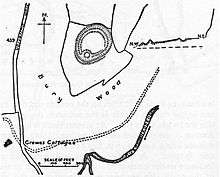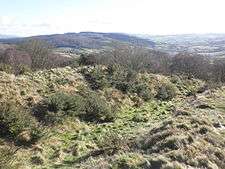Bury Castle, Selworthy
| Bury Castle | |
|---|---|
| Selworthy, Somerset, England | |
|
The site of Bury Castle | |
 Bury Castle | |
| Coordinates | grid reference SS917471 |
| Type | Hillfort |
| Site information | |
| Owner | National Trust |
| Open to the public | Yes |
Bury Castle is an Iron Age hill fort near Selworthy, Somerset, England.[1] It has been scheduled as an ancient monument.[2]
History

Bury Castle was built on a spur of land overlooking the surrounding terrain.[3] The Bury Castle hillfort covers 0.2 hectares (0.49 acres) in internal area. The main enclosure has a single rampart and ditch, with steep drops on the north, east and south sides. The bank is up to 1.6 metres (5 ft 3 in) high with a ditch 2 metres (6 ft 7 in) deep.[4] There is an additional rampart 30 metres (98 ft) to the west, with a deep ditch. The rampart is revetted with drystone walling.[1][5]
Hill forts developed in the Late Bronze and Early Iron Age, roughly the start of the first millennium BC.[6] The reason for the emergence of hillforts in Britain, and their purpose, has been a subject of debate. It has been argued that they could have been military sites constructed in response to invasion from continental Europe, sites built by invaders, or a military reaction to social tensions caused by an increasing population and consequent pressure on agriculture. The dominant view since the 1960s has been that the increasing use of iron led to social changes in Britain. Deposits of iron ore were located in different places to the tin and copper ore necessary to make bronze, and as a result trading patterns shifted and the old elites lost their economic and social status.[7] Archaeologist Barry Cunliffe has argued that while widespread war was not typical during the period, hill forts reflected the tensions at the time, and did provide defensive strongholds when conflicts broke out, as well as playing an important political role for the new elites.[8]
Today
Bury Castle is today protected as a Scheduled Ancient Monument[2] and owned by the National Trust.[1] It has been added to the Heritage at Risk register due to vulnerability from scrub or tree growth.[9]
See also
- Castles in Great Britain and Ireland
- List of castles in England
- List of hill forts and ancient settlements in Somerset
References
- 1 2 3 "Bury Castle". National Monument Record. English Heritage. Archived from the original on 25 February 2012. Retrieved 21 March 2011.
- 1 2 "Bury Castle, an Iron Age defended settlement". National Heritage List for England. Historic England. Retrieved 31 October 2016.
- ↑ "Bury Castle, an Iron Age defended settlement, No:24025". Somerset Historic Environment Record. Somerset County Council. Retrieved 16 July 2011.
- ↑ "Bury Castle, Selworthy". Exmoor Historic Environment Record. Exmoor National Park. Retrieved 1 November 2016.
- ↑ "Bury Castle". Exmoor Historic Environment Record. English Heritage. Retrieved 21 March 2011.
- ↑ Payne, Andrew; Corney, Mark; Cunliffe, Barry (2007), The Wessex Hillforts Project: Extensive Survey of Hillfort Interiors in Central Southern England, English Heritage, p. 1, ISBN 978-1-873592-85-4
- ↑ Sharples, Niall M (1991), English Heritage Book of Maiden Castle, London: B. T. Batsford, pp. 71–72, ISBN 0-7134-6083-0
- ↑ Time Team: Swords, skulls and strongholds, Channel 4, 2008-05-19, retrieved 16 September 2009
- ↑ "Bury Castle, an Iron Age defended settlement, Selworthy, West Somerset — Exmoor (NP)". Heritage at Risk. English Heritage. Retrieved 20 October 2013.
Further reading
- Adkins l and R, 1992. A Field Guide to Somerset Archaeology.
- Burrow E J, 1924. Ancient Earthworks and Camps of Somerset.
- Burrow I, 1981. Hillforts and Hilltop Settlements of Somerset.
Coordinates: 51°01′54″N 3°30′57″W / 51.0316°N 3.5159°W
